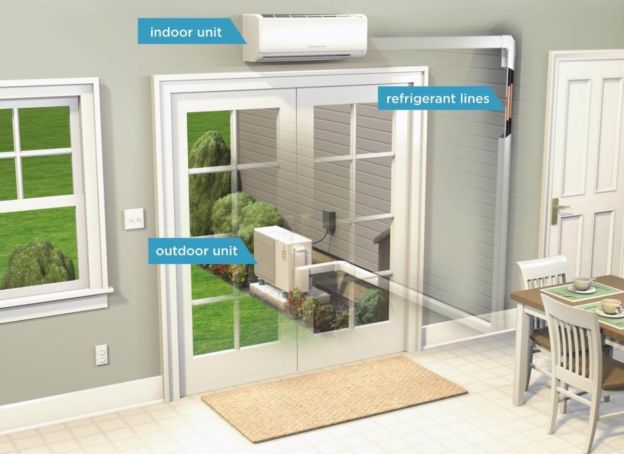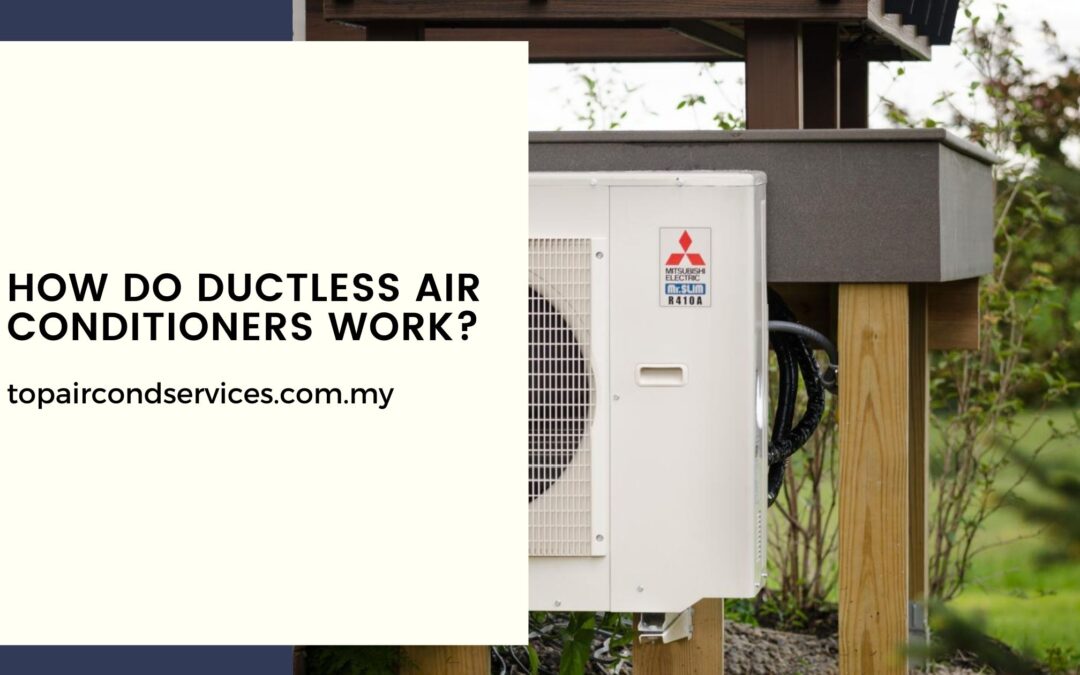How Does A Ductless Air Conditioner Work

Frequently Asked Questions: How Does a Ductless Air Conditioner Work?
Ductless air conditioning, also known as mini-split systems, offer a flexible and efficient way to cool and heat individual rooms or zones without the need for extensive ductwork. This FAQ aims to answer the most common questions about how these systems function, their benefits, and important considerations before purchasing.
Q1: What exactly *is* a ductless air conditioner, and how is it different from a traditional AC?
A ductless air conditioner, or mini-split system, is a cooling and heating system that doesn't rely on a network of ducts to distribute air. Unlike traditional central AC units, which use a single outdoor compressor to cool an entire building via ducts, ductless systems have two main components:
- Outdoor Unit (Compressor/Condenser): This unit sits outside your home or building and contains the compressor, condenser coil, and fan. It's responsible for removing heat from the refrigerant.
- Indoor Unit (Air Handler): This unit is mounted on a wall or ceiling inside the room you want to cool or heat. It contains a cooling coil and a fan that blows cool air into the room.
The key difference lies in the absence of ductwork. Instead, the outdoor and indoor units are connected by a conduit containing refrigerant lines, power cables, and a condensate drain. This makes installation simpler and eliminates energy loss associated with leaky ducts.
Q2: Can you break down the cooling process step-by-step? How does the refrigerant actually work?
The cooling process of a ductless air conditioner involves a cycle of refrigerant that absorbs and releases heat. Here's a simplified breakdown:
- Refrigerant Absorption: Warm air from the room is drawn over the cooling coil in the indoor unit. This coil contains cold, low-pressure refrigerant. The refrigerant absorbs the heat from the air, causing it to evaporate and turn into a low-pressure gas.
- Refrigerant Compression: The low-pressure, gaseous refrigerant travels through the refrigerant lines to the compressor in the outdoor unit. The compressor pressurizes the refrigerant, which significantly increases its temperature.
- Heat Release (Condensation): The high-pressure, hot refrigerant flows into the condenser coil in the outdoor unit. Here, the refrigerant releases its heat to the outside air, aided by the fan. As it releases heat, the refrigerant condenses back into a high-pressure liquid.
- Expansion Valve: The high-pressure, liquid refrigerant then passes through an expansion valve. This valve reduces the pressure of the refrigerant, causing it to cool down significantly and become a low-pressure, cold liquid – ready to start the cycle again.
- Cycle Repeats: This cold, low-pressure liquid refrigerant travels back to the indoor unit, and the entire process repeats, continuously removing heat from the room.
Refrigerant acts as the heat transfer medium. It’s a special chemical that readily changes between liquid and gaseous states depending on pressure and temperature, allowing it to efficiently absorb and release heat.
Q3: What about heating? How does a ductless system provide heat, and is it efficient for that too?
Many ductless air conditioners also function as heat pumps, providing both cooling and heating. When in heating mode, the system essentially reverses the cooling process.
- Refrigerant Absorption (Outdoor Unit): Even in cold weather, there is some heat present in the outside air. The refrigerant in the outdoor unit absorbs this heat, causing it to evaporate into a low-pressure gas.
- Refrigerant Compression: The compressor in the outdoor unit pressurizes the refrigerant, raising its temperature.
- Heat Release (Indoor Unit): The high-pressure, hot refrigerant flows to the indoor unit and releases its heat into the room, warming the air. As it releases heat, the refrigerant condenses back into a high-pressure liquid.
- Expansion Valve: The high-pressure, liquid refrigerant passes through the expansion valve, reducing its pressure and temperature.
- Cycle Repeats: The cold, low-pressure liquid refrigerant then travels back to the outdoor unit, and the heating cycle repeats.
Efficiency: Ductless heat pumps can be very efficient for heating, especially in moderate climates. Their efficiency is measured by a Heating Seasonal Performance Factor (HSPF). Higher HSPF ratings indicate greater efficiency. However, their heating efficiency may decrease significantly in extremely cold temperatures. In very cold climates, supplemental heating might be necessary.
Q4: What are the key benefits of using a ductless system compared to other options?
Ductless air conditioning systems offer several advantages over traditional central AC and window units:
- Energy Efficiency: Because they don't lose energy through leaky ducts, ductless systems are generally more energy-efficient. Many models boast high SEER (Seasonal Energy Efficiency Ratio) and HSPF ratings, resulting in lower energy bills.
- Zoned Cooling and Heating: You can independently control the temperature in each room or zone served by an indoor unit. This allows for personalized comfort and prevents wasting energy cooling or heating unoccupied spaces.
- Easy Installation: Installation is typically less disruptive than installing ductwork for a central AC system. The connection between the indoor and outdoor units requires only a small hole in the wall.
- Improved Air Quality: Many ductless systems come with advanced air filtration systems that remove dust, allergens, and other pollutants from the air.
- Quiet Operation: Ductless units are generally quieter than window units and many central AC systems. The compressor is located outside, minimizing noise inside the home.
- Space Saving: Indoor units are compact and wall-mounted, saving floor space compared to bulky window units.
- Flexibility: Ideal for additions, renovations, or homes without existing ductwork. They can also supplement existing HVAC systems.
Q5: Are there any downsides to using a ductless system that I should be aware of?
While ductless systems offer many benefits, it's important to consider potential drawbacks:
- Initial Cost: The initial investment for a ductless system can be higher than for window units or even some central AC systems, especially if you need multiple indoor units.
- Aesthetics: Some homeowners find the appearance of the wall-mounted indoor units less appealing than traditional vents. However, indoor units come in various styles, and some can be recessed into the ceiling.
- Installation Complexity: While generally easier than installing ductwork, proper installation requires a qualified HVAC technician. Incorrect installation can lead to performance issues and reduced efficiency.
- Maintenance: Regular maintenance, including cleaning the filters and coils, is essential for optimal performance. Neglecting maintenance can lead to decreased efficiency and potential breakdowns.
- Limited Whole-House Coverage: While multi-zone systems exist, ductless systems are typically best suited for cooling and heating individual rooms or zones. For large homes, a central AC system might be more practical or a combination of both.
- Drainage: The indoor units produce condensate (water) that needs to be drained. Proper drainage is crucial to prevent water damage.
Q6: How do I choose the right size ductless system for my room or home? What factors should I consider?
Choosing the right size ductless system is crucial for efficient cooling and heating. An undersized unit will struggle to maintain the desired temperature, while an oversized unit will cycle on and off frequently, wasting energy and potentially leading to uneven cooling.
Here are some key factors to consider:
- Room Size: The square footage of the room is the most basic factor. Use a BTU (British Thermal Unit) chart as a starting point. As a rule of thumb, 20 BTU per square foot.
- Climate: Homes in hotter climates will generally require larger systems than those in milder climates.
- Insulation: Well-insulated rooms require less cooling and heating capacity. Poor insulation means heat will leak in during the summer and out during the winter.
- Sun Exposure: Rooms with significant sun exposure, especially south-facing rooms, will require more cooling capacity.
- Number of Windows: Windows allow heat to enter the room. More windows generally mean a larger system is needed.
- Ceiling Height: Higher ceilings increase the volume of the room, requiring more cooling and heating capacity.
- Number of Occupants: More people in the room generate more heat.
- Heat-Generating Appliances: Appliances like computers, TVs, and cooking equipment generate heat and can increase the cooling load.
- Professional Consultation: The best way to determine the appropriate size is to consult with a qualified HVAC technician. They can perform a load calculation to accurately assess your cooling and heating needs.
Q7: What kind of maintenance is required for a ductless air conditioner, and how often should it be performed?
Regular maintenance is essential for ensuring the efficient and reliable operation of your ductless air conditioner. Proper maintenance can extend the lifespan of the system and prevent costly repairs.
Here are some key maintenance tasks and their recommended frequency:
- Air Filter Cleaning or Replacement: Clean or replace the air filters every 1-3 months. Dirty filters restrict airflow, reduce efficiency, and can lead to the system overheating. Check the filter monthly and clean or replace as needed.
- Coil Cleaning: Clean the indoor and outdoor unit coils at least once a year. Dust and debris can accumulate on the coils, reducing their ability to transfer heat. A soft brush or a specialized coil cleaner can be used.
- Condensate Drain Line Cleaning: Flush the condensate drain line at least once a year to prevent clogs. Clogged drain lines can cause water damage. You can use a wet/dry vacuum or a specialized drain line cleaner.
- Outdoor Unit Inspection: Regularly inspect the outdoor unit for any obstructions, such as leaves, branches, or debris. Clear away any obstructions to ensure proper airflow.
- Professional Inspection and Tune-Up: Schedule a professional inspection and tune-up at least once a year. A qualified HVAC technician can check the refrigerant levels, inspect the electrical components, and perform other necessary maintenance tasks.
- Refrigerant Check: Have a professional check the refrigerant levels periodically. Low refrigerant levels can indicate a leak, which needs to be addressed promptly.
By following these maintenance guidelines, you can keep your ductless air conditioner running efficiently and reliably for years to come.










